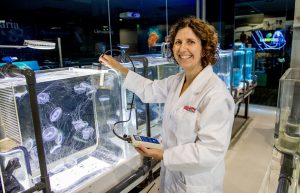Queensland’s zoo and aquarium tourism industry may end up dwarfing the Australian Government’s much-needed funding lifeline.
Announced on 28 April by the Minister for Trade, Tourism and Investment the Hon Simon Birmingham, the $94.6 million support package aims to help Australia’s zoos and aquariums through the COVID-19 crisis.

Dr Sarah Gardiner is the Deputy Director of the Griffith Institute for Tourism and is a published researcher on travel consumer behaviour, experience design and innovation.
Griffith Institute for Tourism (GIFT) Deputy Director Dr Sarah Gardiner said the Federal funding was a good start, but given Queensland’s zoo and aquarium industry was the largest of any state or territory in Australia, its importance warranted additional support from the Queensland Government.
“Once the state border reopens, the most important travel market for Queensland’s tourism recovery is high value interstate travellers with children to family friendly destinations.”
She said research into the spending habits of high value domestic travellers reveal they spend on average over $2000 per trip or $300 per night for shorter stays compared to the average traveller.
“GIFT’s research shows 47% of visitors went to a wildlife park or theme park like Sea World, making these attractions a hero experience for the Gold Coast,” Dr Gardiner said.
“GIFT’s research shows 47% of visitors went to a wildlife park or theme park like Sea World, making these attractions a hero experience for the Gold Coast”
“Operators are already planning for ways the public can safely visit attractions and I encourage locals to support zoos and aquariums once they reopen.”
Sea World and Griffith’s research collaboration
Sea World also plays a vital role in marine research and Griffith University houses a laboratory designed for studying sea jellies within the park.
Professor Kylie Pitt, head of Griffith University Marine Science says Sea World incurs considerable expense for feeding and maintaining the health of the sea jellies and other animals.
“I have been out to Sea World periodically and their animals are still getting the best care from a core group of staff,” she said.
According to GIFT’s research into public sentiment on Twitter, Gold Coast locals and visitors held a strong and positive affinity for Sea World, particularly the dolphins.
A spokesperson from Village Roadshow Theme Parks (VRTP), which owns and operates Sea World, said animal welfare remained their number one priority throughout the temporary closure.
“At VRTP it costs us more than $2 million a month to care for the animals across our theme parks and attractions. We go through 200kgs of fish a day at Sea World alone for the dolphins. Sea World also plays a vital role in marine research, rescue, conservation and education efforts.
“We welcome the Government’s support package for the industry. Our industry is a key pillar in tourism and will play an important part in the economic recovery from COVID-19”.

